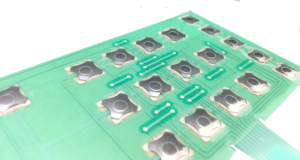How Membrane Layer Switches Contribute to the Longevity of Electronic Control Panels
Membrane layer buttons play a critical function in boosting the toughness of digital control panels, mainly through their multi-layered building which provides efficient security against ecological aspects such as moisture and dust. The absence of moving parts significantly minimizes the probability of mechanical failings, making membrane switches ideal for demanding applications.
Interpretation of Membrane Layer Buttons

Membrane switches are developed to be thin and lightweight, making them appropriate for applications where room is restricted. They can be manufactured in various forms, sizes, and shades, providing flexibility in design that fulfills aesthetic and useful demands. Furthermore, membrane layer buttons can integrate different innovations, such as responsive feedback and LED signs, enhancing user experience.
As a result of their construction, membrane layer buttons are typically immune to dust, moisture, and basic wear, contributing to their toughness in requiring environments. Their seamless style not only promotes very easy cleaning however also reduces the risk of mechanical failure, making them a favored option for makers seeking reliable interface in their electronic control board.
Defense Against Ecological Elements
The layout of membrane changes naturally provides a level of security versus different environmental aspects, which is essential for keeping functionality in difficult conditions - Membrane Switch. These switches are normally created with layers of versatile materials that shield inner components from wetness, dirt, and pollutants. By encapsulating the wiring, membrane layer switches lessen the danger of short circuits and corrosion, which can dramatically impair efficiency
Additionally, using durable adhesives and sealers throughout manufacturing boosts their resistance to ecological difficulties. Membrane switches can endure direct exposure to chemicals and solvents, making them appropriate for industries such as food processing and health care, where health and sanitation are extremely important. Their smooth surface area design likewise prevents the buildup of dust and microorganisms, promoting less complicated cleaning and maintenance.
Temperature changes are one more environmental concern, and membrane switches are crafted to work successfully across a variety of temperatures (Membrane Switch). This adaptability makes sure that control board remain functional in various settings, from industrial atmospheres to customer electronic devices
Effect On Individual Interaction
Customer communication with electronic straight from the source control panels is considerably influenced by the layout and performance of membrane layer switches. These switches supply a responsive interface that boosts the total individual experience, enabling user-friendly navigation and control. Their receptive nature makes sure that customers get immediate feedback upon activation, which is important for tasks requiring precision and effectiveness.
Furthermore, the smooth surface area of membrane changes facilitates very easy cleaning and upkeep, advertising customer self-confidence in the dependability of the interface. This cleanliness is especially crucial in atmospheres where health is extremely important, such as clinical or food processing setups. Additionally, the compact and light-weight design of membrane layer switches adds to the aesthetic allure of control board, motivating individual interaction via a modern-day and smooth look.
In addition, the combination of visual elements, such as published symbols and backlighting, aids individuals promptly identify functions, decreasing the discovering contour connected with new equipment. Consequently, customers can run gadgets a lot more effectively, bring about boosted efficiency and fulfillment. In recap, membrane buttons play a pivotal function in improving user interaction by incorporating capability, looks, and convenience of usage, eventually resulting in improved operational performance.
Style Adaptability and Customization
Layout adaptability and modification are crucial facets of membrane layer buttons, making it possible for producers to tailor electronic control panels to particular applications and user needs. This versatility allows for the assimilation of various style aspects, such as colors, graphics, and textures, which can improve the visual charm and user interaction of the control board.
Membrane buttons can be personalized in shapes and size, suiting a broad array of devices and applications, from commercial equipment to consumer electronics. This versatility guarantees that suppliers can create user-friendly user interfaces that straighten with customer expectations and operational needs. Furthermore, the ability to incorporate special functions such as backlighting or tactile responses further enhances usability, permitting a more interactive experience.
Furthermore, the manufacturing my response procedure for membrane switches over sustains the fast prototyping of designs, allowing suppliers to iterate and improve their ideas quickly. This capability not just increases the advancement timeline yet additionally makes sure that the final item meets particular useful and visual criteria.

Cost-Effectiveness and Long Life
Cost-effectiveness and durability are significant advantages of membrane buttons, making them an attractive alternative for suppliers and end-users alike. These switches are normally cheaper to produce than traditional mechanical buttons, primarily as a result of their streamlined manufacturing processes and the minimized number of components called for. This price advantage prolongs not just to initial production but likewise to lasting functional expenses, as membrane layer buttons typically require less upkeep and have a lower failing rate.
Furthermore, the long life of membrane layer switches contributes to their general value. Created from resilient materials, they are resistant to environmental elements such as dampness, dirt, and chemicals, which can bring about early wear in various other button kinds. The absence of moving components minimizes mechanical failure, permitting membrane click for more layer changes to preserve capability over prolonged durations.
This sturdiness is particularly advantageous in applications needing constant efficiency under demanding conditions, such as medical gadgets and industrial devices. Eventually, the mix of cost-effectiveness and durability makes membrane switches a financially feasible option for producers, supplying trusted solutions that endure the examination of time while optimizing budgetary considerations.
Conclusion
Finally, membrane switches considerably boost the sturdiness of electronic control board with their robust construction and protective attributes. By efficiently protecting wiring from environmental dangers and minimizing the threat of mechanical failure, these switches guarantee constant efficiency sought after applications. The seamless design advertises health and simplicity of upkeep, while customization options allow tailored solutions for different requirements. Overall, membrane layer changes stand for a dependable and cost-efficient selection for improving the longevity and functionality of electronic control systems.